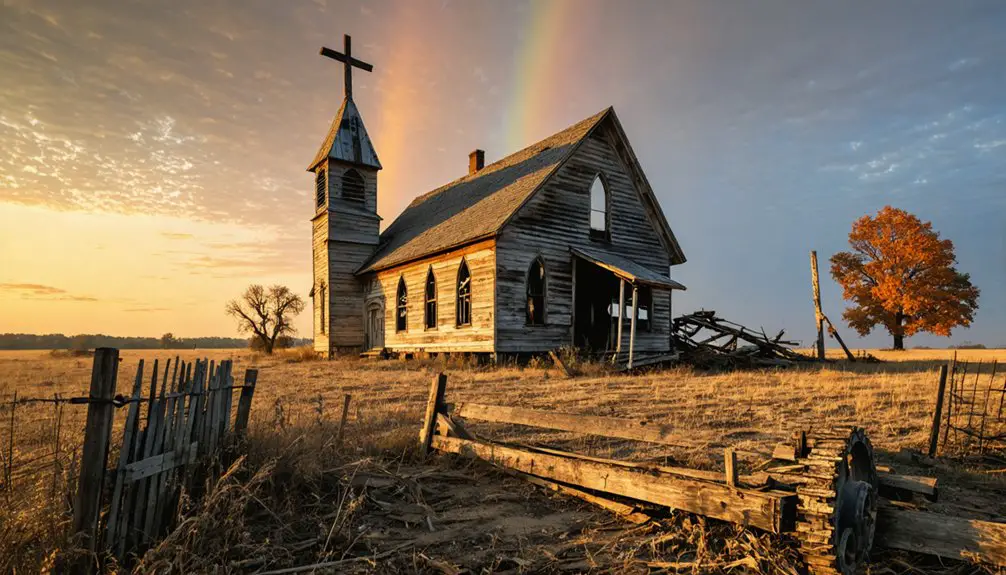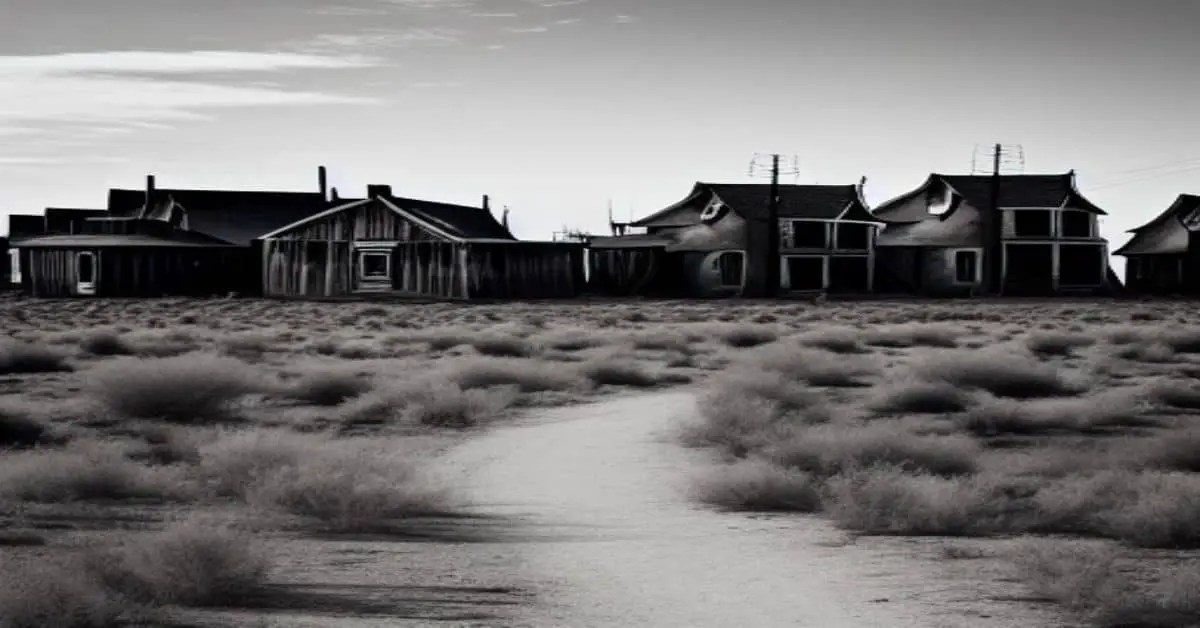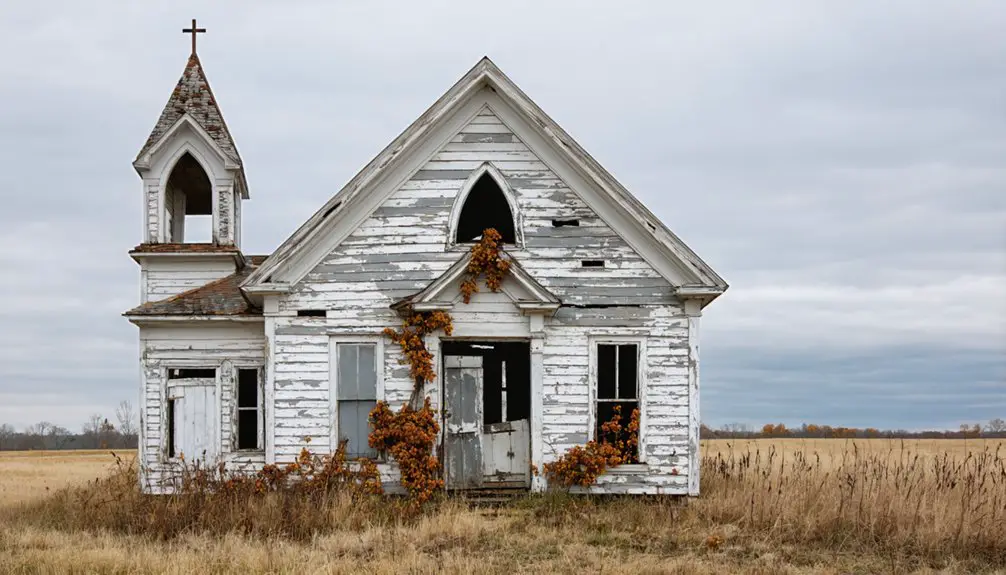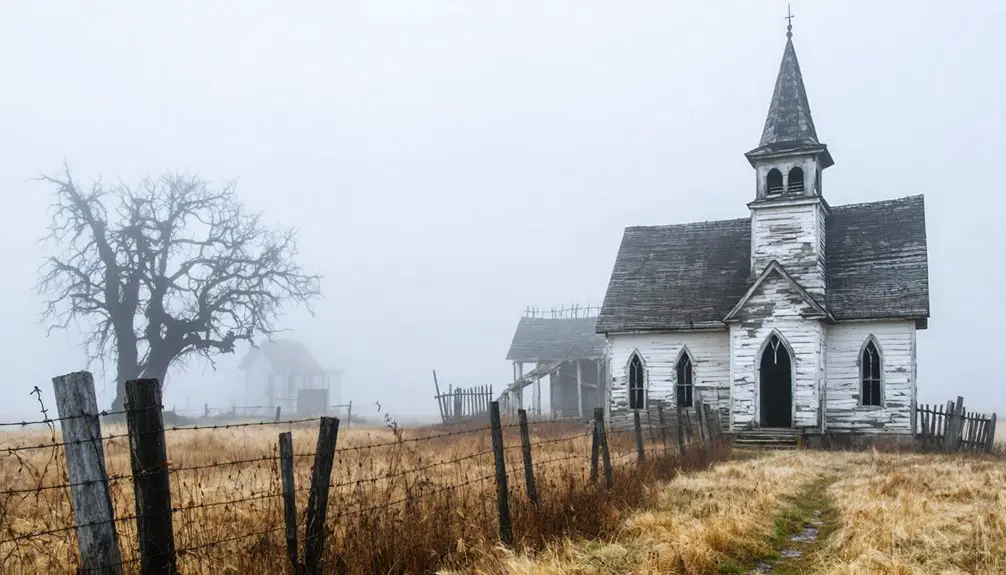You’ll find Red Oak II northeast of Carthage, Missouri, where artist Lowell Davis recreated a ghost town from the remnants of the original Red Oak community. After discovering his childhood town abandoned in 1974, Davis purchased Fox Fire Farm in 1987 and began relocating historic buildings to create a living museum. Today, you can explore authentic structures like the vintage Phillips 66 station and general store without an entrance fee. The site’s dozen residents maintain Davis’s vision of preserved rural American life.
Key Takeaways
- Red Oak was established 18-20 miles northwest of Carthage, Missouri, thriving initially with general stores, blacksmith shops, and farms.
- The town experienced population decline after World War II and became a ghost town by the 1970s.
- Artist Lowell Davis purchased Fox Fire Farm in 1987 to preserve Red Oak’s history by relocating original buildings.
- The preserved site, renamed Red Oak II, features authentic structures including a vintage Phillips 66 station and schoolhouse.
- Today, Red Oak II operates as an open-air museum near Route 66, maintained by residents who preserve its historical character.
The Rise and Fall of Original Red Oak
While the Ozarks region attracted numerous settlers in the early 19th century, Original Red Oak emerged as a notable settlement approximately 18-20 miles northwest of Carthage, Missouri.
You’ll find that settlement patterns followed the typical frontier strategy – hardy pioneers sought fertile bottomlands near water sources and forests, establishing homesteads under various land claim laws. Early settlers relied on community house-raising events to construct their first log cabins with neighbors helping neighbors.
The town flourished with the essential elements of rural life: general stores, blacksmith shops, schools, and surrounding farms. Residents embraced self-sufficient agricultural practices, raising pigs and growing corn as dietary staples. Artist Lowell Davis was born in this thriving community.
They’d gather for preacher-led meetings and conduct business around farming interests.
However, post-World War II urbanization dealt a fatal blow. As residents sought opportunities in cities, Original Red Oak’s population dwindled until it became a ghost town by the 1970s.
Artist Lowell Davis’s Vision and Return
When artist Lowell Davis returned to his hometown of Red Oak, Missouri in 1974, he found little more than scattered ruins and memories of the once-thriving community.
You’ll understand Davis’s artistic vision when you learn how he purchased Fox Fire Farm near Carthage and began relocating buildings from the original Red Oak in 1987, transforming discarded structures into a living canvas.
His creation of Red Oak II stands as both an artistic statement and a preservation of rural American life, where relocated historic buildings form a carefully curated community that keeps the spirit of the original town alive. Despite struggling with arthritis in later years, Davis continued to enhance the site through his distinctive sculptures and artistic additions. His beloved Bell Star House became his residence until his death in 2020.
Coming Home to Nothing
After leaving his childhood hometown of Red Oak, Missouri, artist Lowell Davis returned in the 1970s to find nothing but abandonment and decay.
The once-vibrant rural community had succumbed to post-WWII urban migration and economic hardship, leaving only empty buildings and fading memories.
This homecoming nostalgia sparked Davis’s ambitious vision to preserve what remained of his past. In 1987, you’d have found him purchasing original buildings from Red Oak and nearby ghost towns, moving them piece by piece to his farm near Carthage. Today, Knell Mortuary services continue preserving the area’s heritage just minutes from Davis’s recreated town.
Growing up in an old general store shaped his deep connection to the area and fueled his preservation efforts.
Through memory reconstruction, he transformed these forgotten structures into Red Oak II, breathing new life into the artifacts of his childhood.
Davis didn’t just save buildings – he created a living artwork that captured the essence of early 20th-century rural America.
Recreating Lost Memories
Throughout the late 1980s, artist Lowell Davis commenced on an extraordinary mission to resurrect his lost hometown through a unique blend of sculpture and architectural preservation. In 1987, he began purchasing buildings from the original Red Oak and moving them to his family’s land, breathing new life into these forgotten structures around a small lake.
Davis’s memory reconstruction project went beyond mere preservation – he transformed discarded buildings into living sculptures, crafting a three-dimensional artwork that you can walk through and experience.
His nostalgia revival captured the essence of rural simplicity, from the restored Phillips 66 station to the whimsical cemetery. You’ll find each carefully placed structure tells part of a larger story, serving as both a functional space and an artistic statement about America’s vanishing small-town heritage.
Art Preserves Rural Life
Driven by an unwavering passion to preserve rural heritage, artist Lowell Davis transformed Fox Fire Farm into a living representation of small-town America. His artistic expression went beyond conventional mediums, as he meticulously relocated and restored buildings from the original Red Oak and surrounding ghost towns.
Through community engagement, he created a space that celebrates the authentic spirit of rural life.
- You’ll discover carefully preserved early 20th-century structures, including Belle Starr’s house and a Phillips 66 gas station.
- You’re immersed in a thoughtfully designed layout around a small lake, where every building tells a story.
- You’re connected to America’s rural past through Davis’s innovative use of reclaimed materials and found objects.
This living museum stands as a symbol of Davis’s vision, drawing visitors worldwide who seek to experience the essence of vanished rural communities.
Building Red Oak II: A Town Reborn
You’ll find Red Oak II stands as a tribute to architectural preservation, where Lowell Davis meticulously relocated and restored buildings from the original Red Oak and nearby ghost towns.
Davis’s vision centered on salvaging authentic structures like the blacksmith shop, general store, and schoolhouse before they were lost to time and decay. Known as the “Norman Rockwell” of rural art, Davis dedicated himself to preserving small-town American culture through his work.
In reconstructing these historic buildings on his farm near Carthage, he created not just a collection of old structures, but a cohesive village that captures the essence of early 20th-century rural America. Four historic buildings have been transformed into bed and breakfast accommodations for visitors.
Preserving Historical Architecture
When artist Lowell Davis undertook the ambitious project of preserving Red Oak’s architectural heritage in 1987, he didn’t just relocate buildings – he breathed new life into an entire community’s history.
His vision for architectural authenticity meant carefully selecting and moving structures that represented rural American small-town life from the 1900s-1930s, including his great-grandfather’s blacksmith shop. The project features a prominent Feed and Seed store that exemplifies the agricultural roots of the community.
Through dedicated community engagement, the project evolved from an art exhibit into a living, breathing settlement.
You’ll find:
- Original buildings from Red Oak, meticulously restored to their former glory
- Period-accurate additions that complete the historic townscape
- Vintage cars, farm equipment, and carefully maintained landscapes that transport you back in time
Today, about a dozen residents maintain these historic structures, ensuring their preservation while creating a unique blend of past and present. The site spans roughly 60 acres of preserved Americana, showcasing Davis’s dedication to rural heritage.
Vision Behind Relocation
The remarkable rebirth of Red Oak began in a humble cornfield on Lowell Davis’s Fox Fire Farm near Carthage, Missouri. When Davis witnessed his childhood town of Red Oak falling into decay, he envisioned more than just preserving buildings – he saw an opportunity to breathe new life into a dying community.
The relocation challenges were immense, requiring buildings to be cut in half or dismantled piece by piece for nighttime transport.
But Davis’s artistic vision went beyond mere preservation. He carefully selected and arranged structures from the late 19th to early 20th centuries, creating a living museum that would continue to thrive.
The community impact has been lasting, with about a dozen residents now calling the relocated buildings home, ensuring Red Oak II remains a vibrant representation of rural American life.
Historical Buildings and Their Stories
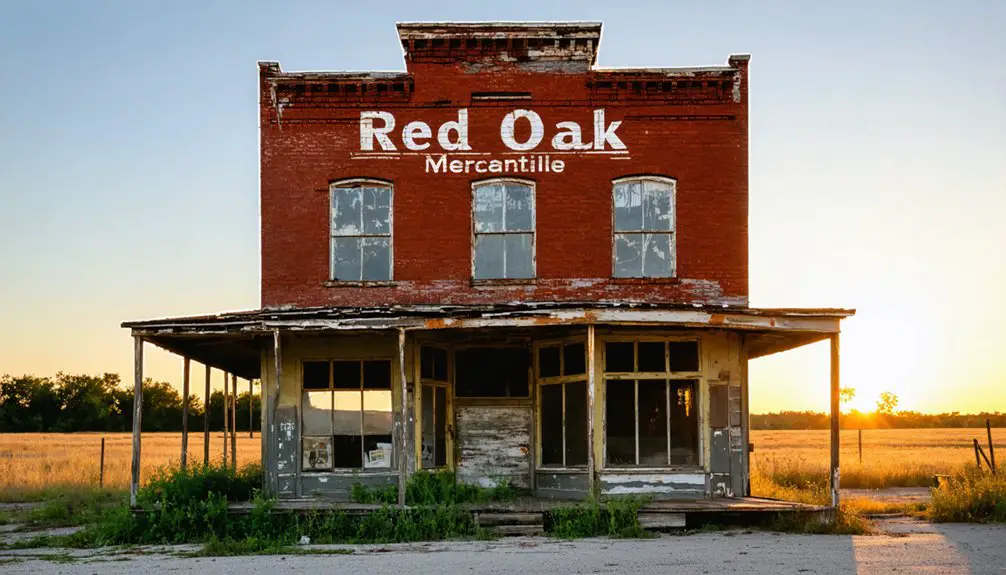
Architectural treasures from original Red Oak, Missouri found new life when artist Lowell Davis commenced on an ambitious preservation project, moving numerous historic structures to his family land near Carthage.
These buildings, representing early 20th-century architectural styles, stand as monuments to rural America’s historical significance.
Rural architecture tells the story of America’s heartland, preserving our cultural heritage through weathered wood and enduring stone.
- The Belle Starr house, once home to a notorious outlaw, now serves as a centerpiece of authentic frontier heritage.
- A vintage Phillips 66 station captures the spirit of America’s early automotive independence.
- The old schoolhouse, general store, and feed store showcase the self-reliant spirit of rural commerce.
You’ll find these carefully preserved structures along a gravel road, each maintained by private owners who understand their role in keeping this slice of Missouri history alive.
While some buildings serve as private residences, others remain as museum-style exhibits, allowing you to step back in time.
Life in a Living Art Installation
Inside Red Oak II, roughly a dozen families have created an extraordinary living experiment where daily life seamlessly blends with artistic expression.
You’ll find residents tending period-authentic gardens, maintaining restored buildings, and living among Lowell Davis’s scattered sculptures and installations that dot the landscape.
Community engagement takes many forms here, from operating the old-fashioned general store to participating in walking tours that showcase the town’s artistic heritage.
You’re witnessing a unique fusion where art meets daily life – residents don’t just preserve history, they’re living it.
Their homes, relocated from the original Red Oak and nearby ghost towns, serve as both functional dwellings and pieces of a larger artistic vision.
It’s a deliberate choice to embrace a lifestyle that honors rural American values while contributing to an evolving art installation.
Preserving Rural Missouri Heritage
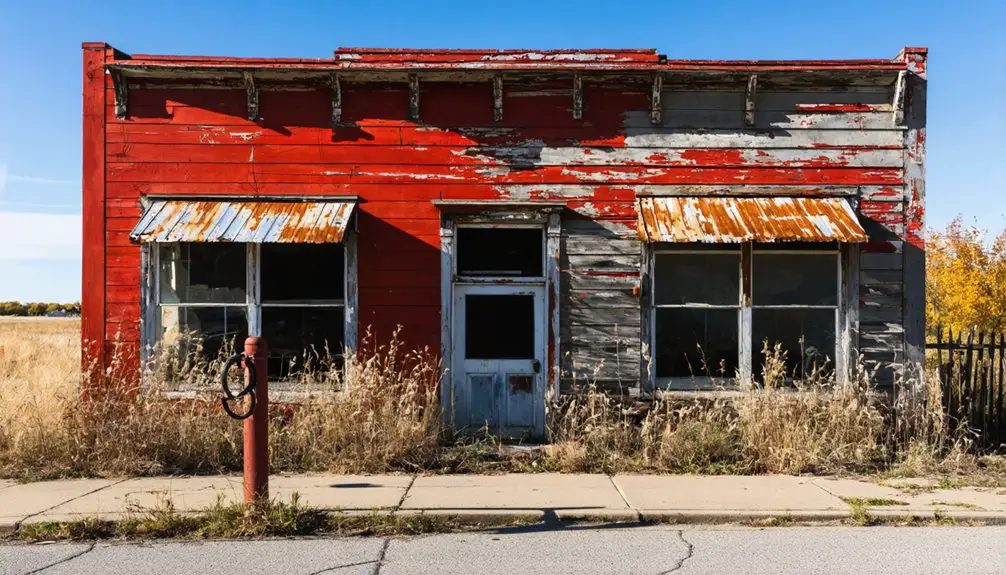
While historic rural communities across Missouri face mounting preservation challenges, a strong network of state programs and partnerships works diligently to protect these cultural treasures.
You’ll find extensive support through Missouri’s enhanced Historic Tax Credit program and the State Historic Preservation Office’s cultural resource surveys, which help safeguard these irreplaceable assets.
- You’re part of a crucial community engagement network that’s preserving over 104,000 documented historic sites across the state.
- Your local heritage education initiatives can now tap into nonprofit tax credits, making preservation more accessible than ever.
- You’ve got access to thorough GIS mapping and conservation strategies that unite wildlife, landscape, and cultural preservation efforts.
These collaborative approaches guarantee Missouri’s rural heritage sites, including places like Red Oak, continue telling their unique stories for generations to come.
Exploring Red Oak II Today
Modern-day visitors to Red Oak II discover a masterfully curated slice of Missouri’s past, located just northeast of Carthage near historic Route 66.
You’ll find this unique community by traveling east on MO 96, then north on Road 130, followed by a short drive down Kafir Road.
As you explore the gravel roads, you’ll encounter authentic pieces of rural Americana: a restored general store, Phillips 66 gas station, and schoolhouse create nostalgic experiences at every turn.
While the buildings are privately owned, community engagement thrives as visitors respectfully explore this open-air museum.
You’re free to wander among vintage artwork and preserved farm machinery, though remember to stay on designated paths.
There’s no entrance fee, but donations are appreciated at this remarkable blend of historical preservation and artistic vision.
The Legacy of a Ghost Town Artist
Through the visionary work of Lowell Davis, Red Oak II stands as a tribute to the power of artistic preservation.
Often compared to Norman Rockwell, Davis transformed a ghost town’s remnants into a living masterpiece that captures the essence of rural nostalgia. His creative vision wasn’t just about saving buildings; it was about preserving the soul of a vanishing way of life.
Like a painter with buildings as his canvas, Davis preserved not just architecture, but the heartbeat of rural America itself.
- You’ll feel the weight of history in each carefully placed structure, from the Belle Starr house to the vintage Phillips 66 station.
- You’ll discover authentic pieces of Americana that tell stories of self-sufficiency and neighborly values.
- You’ll experience the artistic transformation of loss into legacy, as Davis turned abandonment into inspiration.
Davis’s passing in 2020 marked the end of an era, but his artistic legacy to rural American life continues to inspire visitors seeking connection to their roots.
Frequently Asked Questions
Are There Guided Tours Available at Red Oak II?
You won’t find official guided experiences at Red Oak II, but you’re free to explore independently along the gravel roads, discovering historical insights through the restored buildings and artwork at your own pace.
What Are the Best Times of Year to Visit?
You’ll find the most rewarding visits during spring when native flowers bloom and buildings open more frequently, or autumn when vibrant colors transform the landscape and temperatures stay comfortably cool.
Can Visitors Stay Overnight in Any of the Historic Buildings?
You can’t stay overnight in the historic buildings as they’re privately owned. However, you’ll find dedicated overnight accommodations in separate rustic cabins that let you experience the village atmosphere.
Does Red Oak II Host Any Annual Events or Festivals?
You won’t find ghost tours here, but you’ll discover vibrant festivals like the Red Oak II Festival and Farm Fest, plus weekly jam sessions at Salem Country Church featuring bluegrass and gospel music.
Are There Any Dining or Shopping Options Within Red Oak II?
Your dining options and shopping experiences are quite limited, as the diner and general store are primarily historical exhibits. You’ll find these buildings are privately owned and not fully operational businesses.
References
- https://www.atlasobscura.com/places/red-oak-ii
- https://www.latimes.com/archives/la-xpm-1992-12-06-mn-3376-story.html
- https://www.experiencecarthagemo.com/redoakii
- https://www.youtube.com/watch?v=OOTAehpG9mk
- https://www.hmdb.org/m.asp?m=251593
- https://shilohmuseum.org/project/settling-the-ozarks-2/
- https://www.youtube.com/watch?v=qglOUZvc3Mc
- https://www.redoaktx.org/1106/History-of-Red-Oak
- https://carthagecouncilonthearts.org/carthage-art-history/forged-in-fire-mural-stands-as-a-tribute-to-lowell-davis-love-for-home-and-nature/
- https://www.routemagazine.us/stories/looking-back
